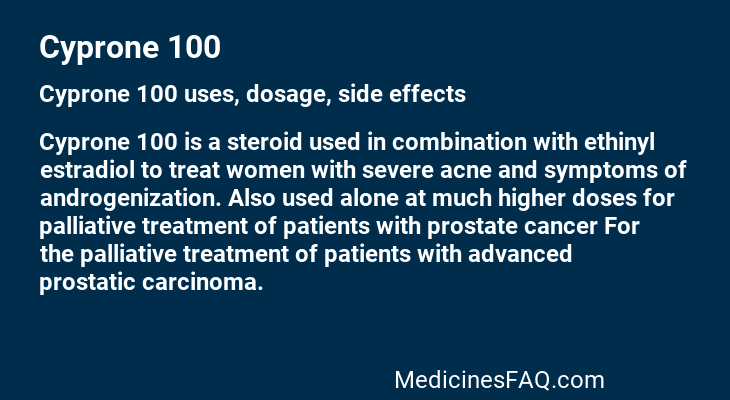Cyprone 100
Cyprone 100 Uses, Dosage, Side Effects, Food Interaction and all others data.
An anti-androgen that, in the form of its acetate (cyproterone acetate), also has progestational properties. It is used in the treatment of hypersexuality in males, as a palliative in prostatic carcinoma, and, in combination with estrogen, for the therapy of severe acne and hirsutism in females.
Cyproterone is an antiandrogen. It suppresses the actions of testosterone (and its metabolite dihydrotestosterone) on tissues. It acts by blocking androgen receptors which prevents androgens from binding to them and suppresses luteinizing hormone (which in turn reduces testosterone levels).
| Trade Name | Cyprone 100 |
| Generic | Cyproterone acetate |
| Cyproterone acetate Other Names | Cyproterone 17-O-acetate, Cyproterone acetate |
| Type | |
| Formula | C24H29ClO4 |
| Weight | Average: 416.938 Monoisotopic: 416.175437123 |
| Groups | Approved, Investigational |
| Therapeutic Class | |
| Manufacturer | |
| Available Country | Australia |
| Last Updated: | September 19, 2023 at 7:00 am |

Uses
Cyprone 100 is a steroid used in combination with ethinyl estradiol to treat women with severe acne and symptoms of androgenization. Also used alone at much higher doses for palliative treatment of patients with prostate cancer
For the palliative treatment of patients with advanced prostatic carcinoma.
Cyprone 100 is also used to associated treatment for these conditions: Advanced Prostate Carcinoma, Menstrual Irregularities, Metastatic Hormone Refractory Prostate Cancer, Osteoporosis, Paraphilia, Postmenopausal Osteoporosis, Primary Amenorrhoea, Secondary Amenorrhea, Severe Acne, Hormone Replacement Therapy
How Cyprone 100 works
The direct antiandrogenic effect of cyproterone is blockage of the binding of dihydrotestosterone to the specific receptors in the prostatic carcinoma cell. In addition, cyproterone exerts a negative feed-back on the hypothalamo-pituitary axis, by inhibiting the secretion of luteinizing hormone resulting in diminished production of testicular testosterone.
Food Interaction
- Avoid alcohol.
- Take after a meal.
Elimination Route
Completely absorbed following oral administration.
Half Life
Elimination Following oral or intramuscular administration, the plasma half-life is 38 and 96 hours, respectively.
Elimination Route
It is excreted approximately 60% in the bile and 33% through the kidneys.
Innovators Monograph
You find simplified version here Cyprone 100







